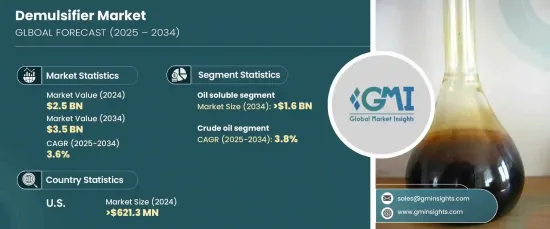
세계의 해유화제 시장은 2024년에는 25억 달러에 달했고, 2025년부터 2034년까지 CAGR 3.6%로 확대될 것으로 전망되고 있습니다.
이 성장의 원동력이 되고 있는 것은 석유 및 가스 산업의 계속적인 확대이며, 특히 북미나 중동 등, 원유 생산량이 계속 증가하고 있는 지역에서 현저합니다. 환경 규제에 대한 대응이 점점 더 중요해지면서 오일 슬러지와 폐수를 효과적으로 관리하기 때문에 보다 효율적인 해유화제의 배합에 대한 수요가 급증하고 있습니다.

이와 병행하여 친환경인 해유화제의 기술 혁신이 진행되어 업계의 지속가능성에 관한 과제에 임하는 동시에 시장의 성장에도 공헌하고 있습니다. 산업화가 가속되고, 특히 아시아태평양에서 에너지 수요가 높아짐에 따라 해유화제 수요도 크게 늘어날 것으로 예상됩니다. 이 지역의 급속한 개발, 특히 에너지 다소비산업은 세계 시장 확대의 주요 요인이며, 첨단 물 분리 기술의 필요성을 더욱 강조하고 있습니다.
| 시장 범위 | |
|---|---|
| 시작연도 | 2024년 |
| 예측연도 | 2025-2034년 |
| 시작금액 | 25억 달러 |
| 예측 금액 | 35억 달러 |
| CAGR | 3.6% |
유용성 해유화제 분야가 시장을 독점해, 2024년에는 16억 달러를 공헌했으며, 예측 기간을 통해 CAGR 3.7%의 속도로 확대할 것으로 예측됩니다. 유용성 해유화제는 원유로부터 수분을 분리하는 능력이 우수하고, 정제 장치를 보호하면서 최종 제품의 품질을 향상시키기 위해 선호되고 있습니다. 이러한 해유화제는 일반적으로 원유에 고농도의 수분과 염분이 함유되어 있으며 분리가 어려운 해상 및 육상 유전에서 특히 효과적입니다. 이러한 까다로운 환경에서 고성능 해유화제가 계속 필요하다는 것이 이 부문의 성장을 더욱 촉진할 것으로 예상됩니다.
원유 분야는 세계 해유화제 시장의 또 다른 주요 견인역으로 2024년 8억 6,810만 달러를 차지했습니다. 이 부문은 2034년까지 3.8%의 연평균 복합 성장률(CAGR)로 원유 생산과 정제 과정에서 해유화제가 수행하는 중요한 역할로 견조하게 성장할 것으로 예측됩니다. 해유화제는 에멀젼의 파괴를 돕고 원유로부터 수분, 염분, 불순물의 분리를 촉진합니다. 이를 통해 정제 공정이 원활하게 진행되고 보다 고품질의 최종 제품을 얻을 수 있기 때문에 해유화제는 세계 석유 생산업체와 정제소에 필수적인 도구가 되고 있습니다.
미국에서는 2024년 해유화제 시장 규모가 6억 2,130만 달러로 예측 기간 동안 CAGR 3.7%로 성장할 것으로 예상됩니다. 미국은 확립된 석유 및 가스 부문, 최첨단 정제 기술, 원유 처리를 강화하는 솔루션에 대한 안정적인 수요의 혜택을 받아 세계 해유화제 시장에서 압도적인 강도를 유지하고 있습니다. 미국의 셰일 붐은 첨단 물 분리 솔루션의 필요성을 지속적으로 추진하여 시장의 주요 기업로서의 입지를 더욱 견고하게 만듭니다.
The Global Demulsifier Market is projected to reach USD 2.5 billion in 2024, with an expected growth rate of 3.6% CAGR from 2025 to 2034. This growth is driven by the ongoing expansion of the oil and gas industry, especially in regions such as North America and the Middle East, where crude oil production continues to rise. The increasing emphasis on meeting environmental regulations has led to a surge in demand for more efficient demulsifier formulations to manage oil sludge and wastewater effectively.

Alongside this, innovations in green demulsifiers are gaining traction, addressing the industry's sustainability challenges while contributing to market growth. As industrialization accelerates and energy needs grow, particularly in Asia-Pacific, the demand for demulsifiers is expected to see significant growth. The region's rapid development, especially in energy-heavy industries, is a key driver for the global market's expansion, placing further emphasis on the need for advanced water separation technologies.
| Market Scope | |
|---|---|
| Start Year | 2024 |
| Forecast Year | 2025-2034 |
| Start Value | $2.5 billion |
| Forecast Value | $3.5 billion |
| CAGR | 3.6% |
The oil-soluble demulsifier segment dominated the market, contributing USD 1.6 billion in 2024, and is anticipated to expand at a rate of 3.7% CAGR throughout the forecast period. Oil-soluble demulsifiers are preferred for their superior ability to separate water from crude oil, improving the quality of the final product while protecting refining equipment. These demulsifiers are particularly effective in both offshore and onshore oil fields, where crude oil typically contains high concentrations of water and salts, which can be challenging to separate. The ongoing need for high-performance demulsifiers in these challenging environments is expected to further propel this segment's growth.
The crude oil segment is another key driver of the global demulsifier market, accounting for USD 868.1 million in 2024. This segment is projected to grow at a robust CAGR of 3.8% through 2034, thanks to the critical role demulsifiers play in crude oil production and refining processes. Demulsifiers help break emulsions, which facilitates the separation of water, salts, and impurities from crude oil. This ensures that the refining process runs smoothly and results in a higher-quality final product, positioning demulsifiers as an essential tool for oil producers and refineries around the world.
In the U.S., the demulsifier market was valued at USD 621.3 million in 2024 and is expected to grow at a CAGR of 3.7% during the forecast period. The U.S. remains a dominant force in the global demulsifier market, benefiting from a well-established oil and gas sector, state-of-the-art refining technologies, and a steady demand for solutions that enhance crude oil processing. The U.S. shale boom continues to drive the need for advanced water separation solutions, further cementing the country's position as a major player in the market.